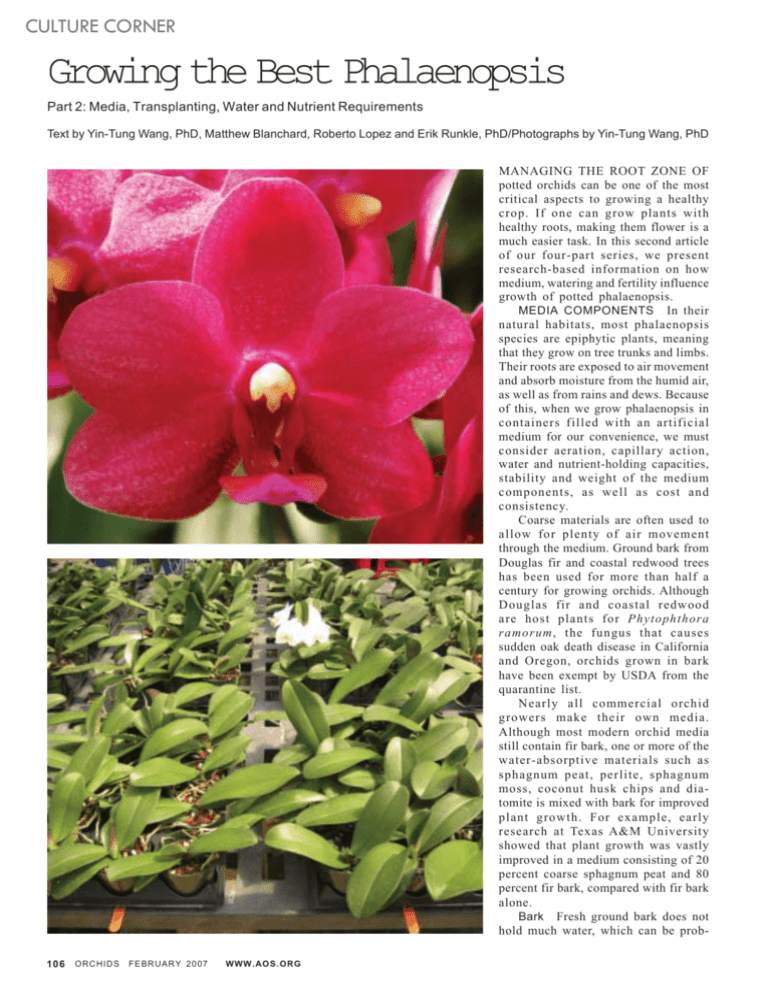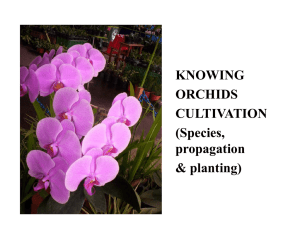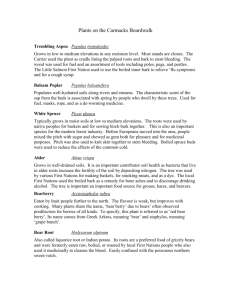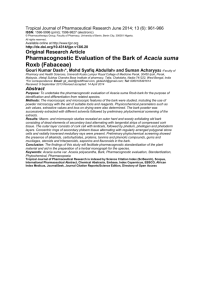Growing the Best Phalaenopsis
advertisement

CULTURE CORNER Growing the Best Phalaenopsis Part 2: Media, Transplanting, Water and Nutrient Requirements Text by Yin-Tung Wang, PhD, Matthew Blanchard, Roberto Lopez and Erik Runkle, PhD/Photographs by Yin-Tung Wang, PhD MANAGING THE ROOT ZONE OF potted orchids can be one of the most critical aspects to growing a healthy crop. If one can grow plants with healthy roots, making them flower is a much easier task. In this second article of our four-part series, we present research-based information on how medium, watering and fertility influence growth of potted phalaenopsis. MEDIA COMPONENTS In their natural habitats, most phalaenopsis species are epiphytic plants, meaning that they grow on tree trunks and limbs. Their roots are exposed to air movement and absorb moisture from the humid air, as well as from rains and dews. Because of this, when we grow phalaenopsis in containers filled with an artificial medium for our convenience, we must consider aeration, capillary action, water and nutrient-holding capacities, stability and weight of the medium components, as well as cost and consistency. Coarse materials are often used to allow for plenty of air movement through the medium. Ground bark from Douglas fir and coastal redwood trees has been used for more than half a century for growing orchids. Although Douglas fir and coastal redwood are host plants for Phytophthora ramorum, the fungus that causes sudden oak death disease in California and Oregon, orchids grown in bark have been exempt by USDA from the quarantine list. Nearly all commercial orchid growers make their own media. Although most modern orchid media still contain fir bark, one or more of the water-absorptive materials such as sphagnum peat, perlite, sphagnum moss, coconut husk chips and diatomite is mixed with bark for improved plant growth. For example, early research at Texas A&M University showed that plant growth was vastly improved in a medium consisting of 20 percent coarse sphagnum peat and 80 percent fir bark, compared with fir bark alone. Bark Fresh ground bark does not hold much water, which can be prob106 ORCHIDS FEBRUARY 2007 WWW.AOS.ORG 1 2 4 lematic when stressed, partially desiccated, bare-root phalaenopsis are newly planted. When bark starts to hold more water and nutrients after repeated watering and fertilization, it decomposes quickly and ties up some of the nutrients. In fact, research has shown there may be no detectable amount of nitrate-nitrogen in a bark medium. Fir bark particles do not have much capillary action and do not readily transfer moisture from the bottom of the pot toward the surface. A medium of fir bark alone can hold too much water in the lower portion of the pot once it begins to degrade, which can lead to severe root rot and poor plant performance. 3 5 6 OPPOSITE ABOVE This Doritaenopsis hybrid (Phal. Buddha’s Treasure × Dor. pulcherrima) inherits the flowering habit of Dor. (syn. Phalaenopsis) pulcherrima and flowers in late spring. It should be grown in light intensities higher than what normally are used for phalaenopsis hybrids. OPPOSITE Phalaenopsis planted in a mix of coarse perlite, coarse sphagnum peat and fir bark (left) and aged Monterey pine bark (right). Plants were provided with a constant fertility of 100 ppm nitrogen from Scotts 15-5-15 Cal Mag. ABOVE Phalaenopsis can be grown in these media components: 1. fresh Douglas fir bark, 2. aged Monterey pine bark, 3. perlite, 4. coarse peat, 5. pumice and 6. a mixture of fresh fir bark, perlite, coarse peat and dust sphagnum moss. LEFT A phalaenopsis plug grown in sphagnum moss showing white, healthy roots (Texas A&M University). The imported aged bark obtained from the Monterey pine, grown in New Zealand for lumber, has been used by an increasing number of orchid growers in the United States. Our preliminary research found that aged Monterey pine bark holds more moisture and nutrients and maintains a higher pH than fir bark, resulting in better plant growth. In addition, this aged pine bark does not decompose as quickly. Sphagnum Moss Pure sphagnum moss is probably the single best material for growing young phalaenopsis in warm (tropical and subtropical) conditions. Most growers transplant plantlets from flasks into plug trays with sphagnum moss as the sole growing medium. Taiwan is the leading exporter of phalaenopsis and nearly all are produced in sphagnum moss. Although moss from New Zealand is of higher quality, many growers use Chilean moss because it is less expensive. Moss has a low pH and absorbs large quantities of water and mineral nutrients. Thus, growers must pay close attention to watering and fertility, especially those located in more temperate climates where pots lose water less rapidly. In addition, inexperienced consumers often overwater plants sold in sphagnum, leading to root rot and plant decline. For these WWW.AOS.ORG FEBRUARY 2007 ORCHIDS 107 CULTURE CORNER reasons, many growers in northern climates avoid using a sphagnum mossbased medium. After a few months’ growing phalaenopsis in sphagnum moss, the root zone pH is often around 3, but, it does not appear to adversely affect the plants’ growth and flowering. TRANSPLANTING Phalaenopsis are often imported into the United States as large bare-root plants, and thus immediate transplanting is necessary. Some domestic nurseries also sell plants as bare-root specimens. Regardless of the medium components, transplanting requires attention to detail and is laborious. Roots should be spread out in pots before medium is added. It is important to fill all spaces among roots with medium so no large air pockets remain in the pot. A stick is sometimes used to carefully push down and compact the medium to hold the plant in place. However, if the medium is compacted too much, it could hold 108 ORCHIDS FEBRUARY 2007 excessive water and have inadequate aeration. If a bark mix is used, do not tap the pots while planting. Tapping will cause the smaller and finer particles to drop to the lower portion of the pot, which could cause more water to stay where it dries the slowest. When planting bare-root plants in sphagnum moss, thoroughly soak the moss in water and squeeze the water out before planting. Depending on the climatic conditions, plants may not need a second irrigation until seven to 14 days later. During this period, a light sprinkling helps recovery. The sprinkling should not be heavy enough to wet the moss. It is also important to ensure that plants are positioned in the container at the correct level. Plants that are planted too deep may have more disease problems and could rot, and those planted too shallow may not root into the medium properly and may not WWW.AOS.ORG have adequate support for flowers. In addition, the container should be filled with medium until the mix is ½ to ¾ inch (1.2 to 1.8 cm) below the top of the pot. This helps facilitate rooting into the medium, not over the rim. It also makes watering the pots easier. Phalaenopsis roots that are exposed to light have chloroplasts and perform photosynthesis. A majority of phalaenopsis growers in Taiwan and the Netherlands, and increasingly growers in the United States, use clear pots that allow light to penetrate the pots. Root photosynthesis likely contributes little to total plant photosynthesis. However, because phalaenopsis roots avoid darkness, roots of plants grown in clear pots generally stay inside the pot better than the roots of plants grown in opaque pots. Roots of plants grown in bark-based media tend to grow out of their pots quickly, whereas those planted in sphagnum moss tend to have their roots stay in the pot much longer. Regardless of medium, after a prolonged period in the same pot, roots eventually grow out of the container. WATERING Growing good orchids requires skillful and attentive watering. The succulent phalaenopsis roots should dry slightly before being wet again. Orchids with pseudobulbs (enlarged stem), such as cattleyas, store water and can withstand periods of drought. However, phalaenopsis lack pseudobulbs and, therefore, are intolerant of extended dry conditions. Phalaenopsis have succulent leaves that do not show signs of stress until several days’ water deficiency. Research has shown that the uptake of carbon dioxide (used in photosynthesis) steadily declines when water is withheld. When subjected to two or three weeks of drought, the excess loss of moisture will cause the succulent leaves to flop and can cause one or more of the lower leaves to turn yellow and abscise. After proper watering has been resumed, recovery is slow, particularly in larger plants. At each watering, enough water should be applied so that a portion of the water (20 to 30 percent) exits from bottoms of the pots. This leaching practice will prevent the accumulation of salts in the medium. Without periodic leaching of the root medium, salts can accumulate and injure the roots. In general, the medium must be allowed to dry before being watered again, but it should never be allowed to dry out completely. Even in hot summer climates, phalaenopsis grown in a bark mix requires watering only every five to seven days in 6-inch (15cm) pots and at four to five day intervals in 4-inch (10-cm) pots. Less frequent watering is appropriate in cooler climates. There is no need to water the dry medium with plain water before applying a fertilizer solution, unless the goal is for flushing out accumulated salts. Maintaining a high relative humidity reduces watering frequency and is conducive to leaf and root growth. We recommend a relative humidity of 70 to 80 percent during vegetative growth. Long ( 1/2 inch [1.2 cm]) brownish or greenish succulent root tips are signs of active plant growth. While plants are in flower, low humidity (20 to 30 percent) can quickly cause the edges of flowers to become dry and papery. OPPOSITE TOP LEFT Phalaenopsis planted FERTILIZER There have been and still are misconceptions about proper fertilization of orchids. In the past, phalaenopsis were mistakenly thought to need little fertilizer because plants were often grown in improper growing media and thus plant growth was poor. Research in the past decade has revealed that phalaenopsis are moderate feeders when grown in more water-absorptive media. When complete fertilizers are used, there is little or no effect of fertilizer type on leaf growth and flowering when grown in a medium containing 20 percent peat and 80 percent bark. Plants supplied with 200 ppm nitrogen at every watering were superior to plants fertilized with 100 ppm of nitrogen (or less) at every watering. Therefore, we recommend in aged Monterey pine bark at King Car Biotechnology Industrial Company. OPPOSITE TOP CENTER Phalaenopsis growing in sphagnum moss at Sogo Team Company. OPPOSITE TOP RIGHT High-soluble salt levels in the medium caused root tips to die. New roots emerged after the medium was leached several times with plain water. OPPOSITE BELOW LEFT Phalaenopsis plantlets newly removed from flasks at Yu-Pin Orchid Nursery. OPPOSITE BELOW RIGHT An excellent crop of phalaenopsis being grown in soft, clear plastic pots filled with sphagnum moss at Taiwan Sugar Corporation. ABOVE Phalaenopsis plants being cleaned of the growing medium at King Car Biotechnology Industrial Company. LEFT Bare-root phalaenopsis plants packed in shredded paper for exporting from Taida Orchids in Taiwan. incorporation of a complete fertilizer delivering 150 to 200 ppm nitrogen at every watering with adequate leaching. Another misconception is that a high concentration of phosphorus ensures excellent flowering. Research has repeatedly shown that many growers have been using excessive concentrations of this nutrient. In one study, phosphorus varying from 22 to WWW.AOS.ORG FEBRUARY 2007 ORCHIDS 109 CULTURE CORNER 242 ppm (with 100 or 200 ppm of nitrogen) did not influence growth or flowering of phalaenopsis. Preliminary research indicates that 25 to 50 ppm phosphorus is adequate to grow an excellent crop. Research has shown that when potting newly imported bareroot phalaenopsis for inducing spiking soon, phosphorus did not affect spiking or flower count during the first flowering season. For growers in cool conditions, consider using a lower fertilizer rate during the flowering cycle due to reduced vegetative growth. Fertilization can be withheld completely once an inflorescence has reached 10 inches (25 cm) in length, or after the first flower has opened, without affecting flower count or size. A recently completed study showed that phalaenopsis that did not receive adequate levels of potassium may appear healthy for several months, producing a similar number and size of new leaves as those receiving adequate potassium. As soon as spiking has taken place and while the young inflorescences grow, the limited pool of potassium in the leaves and roots is remobilized to support the reproductive growth and the lower leaves start to show symptoms of potassium deficiency. Although plants that were deficient of potassium produced flowers, a few lower leaves were lost. All phalaenopsis planted in a bark mix and lacking potassium eventually died. Continuous application of nitrogen ensures flower longevity, but does not increase flower count after the spikes have reached 10 inches (25 cm) in length. Results from a recently completed study at Texas A&M University suggest that fertilizers high in ammoniacal nitrogen are not desirable for the best vegetative growth and flowering. There has been plenty of evidence to suggest that phalaenopsis plants must already have had adequate phosphorus and potassium in their tissues prior to spiking for best performance. Potassium at 200 to 300 ppm ensures high flower count and maximizes flower size. SALINITY Roots of phalaenopsis are sensitive to salinity and can be injured when salts accumulate in the medium. In one study, when salinity of the irrigation water (before adding any fertilizer) increased from 0 to 1.4 dS/m, root fresh weight decreased. Many 110 ORCHIDS FEBRUARY 2007 WWW.AOS.ORG orchid growers have installed reverse osmosis (RO) equipment to provide water that is low in dissolved salts. If straight RO water is used for irrigation for extended periods, supplemental calcium and magnesium must be used to avoid deficiency problems. A desirable electrical conductivity (EC) of the water before adding fertilizer is 0.5 dS/m or less. We recommend that growers maintain a medium leachate of 1.0 to 1.5 dS/m or lower when using the pour-through technique. When medium EC becomes too high (2.0 dS/m), timely leaching with clear water is recommended. Techniques for determining the salt level in the root medium are in the September 2006 issue of Orchids magazine (page 633). The third part of this series in the March 2007 Orchids will focus on light and temperature requirements for vegetative growth and flowering, height control and managing diseases and insects. Acknowledgments The authors thank the Fred C. Gloeckner Foundation, the American Orchid Society, Taiwan Sugar Corporation, Matsui Nursery, Project GREEEN, various local orchid societies, and private greenhouse companies and individuals that support orchid research. Yin-Tung Wang, PhD, is professor of floriculture at Texas A&M University (e-mail yt-wang@tamu.edu). Matthew Blanchard and Roberto “RoLo” Lopez are graduate assistants and Erik Runkle, PhD, is assistant professor and floriculture extension specialist at Michigan State University (e-mail runkleer@msu.edu). The effect of potassium concentration in fertilizer solution on phalaenopsis growth and flowering. The plants received 0, 50, 100, 200, 300, 400, or 500 ppm potassium in the nutrient solution (left to right) since July 1, 2005. These photographs were taken at the Texas A&M University System Ag Research Center, Weslacoon, Texas, on December 12, 2005 (top); February 24, 2006 (middle) and June 28, 2006 (bottom). OPPOSITE ABOVE Many plants of Phalaenopsis Galypso (Brother Delight × violacea) bear fragrant flowers, a trait inherited from the Phal. violacea parent. (This article is part of a series originally published in Greenhouse Grower magazine. It has been modified for orchid enthusiasts with a wide range of growing experiences.) WWW.AOS.ORG FEBRUARY 2007 ORCHIDS 111






